Mohamed Amine Arfaoui
Experimental Demonstration of Over the Air Federated Learning for Cellular Networks
Mar 09, 2025Abstract:Over-the-air federated learning (OTA-FL) offers an exciting new direction over classical FL by averaging model weights using the physics of analog signal propagation. Since each participant broadcasts its model weights concurrently in time and frequency, this paradigm conserves communication bandwidth and model upload latency. Despite its potential, there is no prior large-scale demonstration on a real-world experimental platform. This paper proves for the first time that OTA-FL can be deployed in a cellular network setting within the constraints of a 5G compliant waveform. To achieve this, we identify challenges caused by multi-path fading effects, thermal noise at the radio devices, and maintaining highly precise synchronization across multiple clients to perform coherent OTA combining. To address these challenges, we propose a unified framework for real-time channel estimation, model weight to OFDM symbol mapping and dual-layer synchronization interface to perform OTA model training. We experimentally validate OTA-FL using two relevant applications - Channel Estimation and Object Classification, at a large-scale on ORBIT Testbed and a portable setup respectively, along with analyzing the benefits from the perspective of a telecom operator. Under specific experimental conditions, OTA-FL achieves equivalent model performance, supplemented with 43 times improvement in spectrum utilization and 7 times improvement in energy efficiency over classical FL when considering 5 nodes.
Optimizing Information Freshness Leveraging Multi-RISs in NOMA-based IoT Networks
Aug 02, 2022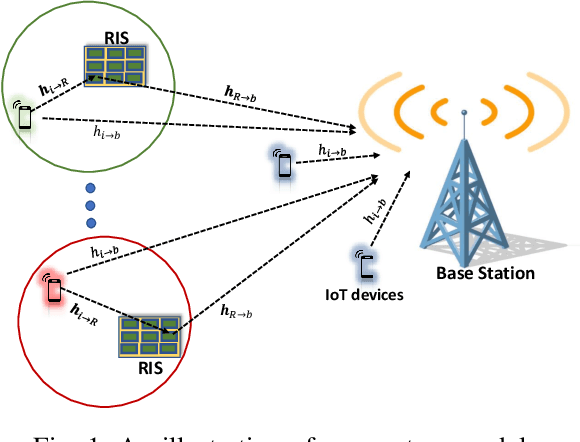

Abstract:This paper investigates the benefits of integrating multiple reconfigurable intelligent surfaces (RISs) in enhancing the timeliness performance of uplink Internet-of-Things (IoT) network, where IoT devices (IoTDs) upload their time-stamped status update information to a base station (BS) using non-orthogonal multiple access (NOMA). Accounting to the potential unreliable wireless channels due to the impurities of the propagation environments, such as deep fading, blockages, etc., multiple RISs are deployed in the considered IoT network to mitigate the propagation-induced impairments, to enhance the quality of the wireless links, and to ensure that the required freshness of information is achieved. In this setup, an optimization problem has been formulated to minimize the average sum Age of Information (AoI) by optimizing the transmit power of the IoTDs, the IoTDs clustering policy, and the RISs configurations. The formulated problem ends up to be a mixed-integer non-convex problem. In order to tackle this challenge, the RISs configurations are first obtained by adopting a semi-definite relaxation (SDR) approach. Then, the joint power allocation and user-clustering problem is solved using the concept of bi-level optimization, where the original problem is decomposed into an outer IoTDs clustering problem and an inner power allocation problem. Optimal closed-form expressions are derived for the inner problem and the Hungarian method is invoked to solve the outer problem. Numerical results demonstrate that our proposed approach achieves lowest AoI compared to the other baseline approaches.
On Optimizing the Power Allocation and the Decoding Order in Uplink Cooperative NOMA
Mar 24, 2022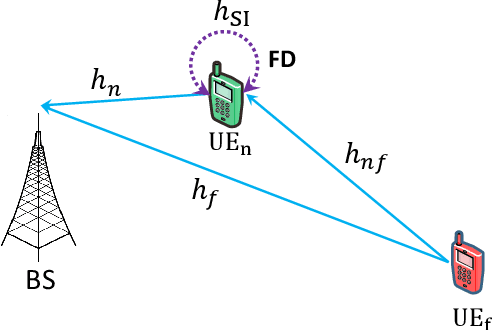

Abstract:In this paper, we investigate for the first time the dynamic power allocation and decoding order at the base station (BS) of two-user uplink (UL) cooperative non-orthogonal multiple access (C-NOMA)-based cellular networks. In doing so, we formulate a joint optimization problem aiming at maximizing the minimum user achievable rate, which is a non-convex optimization problem and hard to be directly solved. To tackle this issue, an iterative algorithm based on successive convex approximation (SCA) is proposed. The numerical results reveal that the proposed scheme provides superior performance in comparison with the traditional UL NOMA. In addition, we demonstrated that in UL C-NOMA, decoding the far NOMA user first at the BS provides the best performance.
Optimizing Information Freshness in RIS-assisted NOMA-based IoT Networks
Feb 28, 2022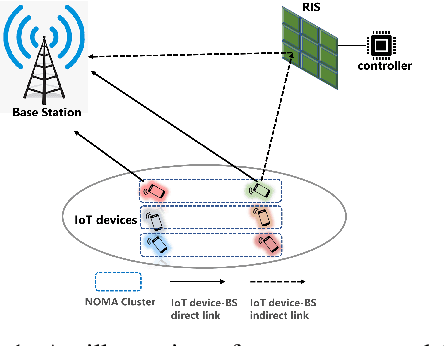

Abstract:This paper investigates the benefits of integrating reconfigurable intelligent surface (RIS) on minimizing the average sum age of information (AoI) in uplink non-orthogonal multiple access-based Internet-of-Things (IoT) networks. In this setup, an optimization problem is formulated to optimize the RIS configuration, the transmit power per IoT device and the clustering policy of IoT devices. The formulated problem is a mixed-integer non-convex one, and in order to solve it we obtain first the RIS configuration by adopting a semi-definite relaxation (SDR) approach. Afterwards, the joint power allocation and user-clustering problem is solved using the concept of bi-level optimization and is decomposed into an outer user clustering problem and an inner power allocation problem. Optimal closed-form expressions are derived for the inner problem and the Hungarian method is employed to solve the outer one. Numerical results demonstrate the performance superiority of our approach.
CoMP Transmission in Downlink NOMA-Based Indoor VLC Cellular Systems
Aug 05, 2021



Abstract:In this paper, we investigate the dynamic power allocation for a visible light communication (VLC) cellular system consisting of two coordinating attocells, each equipped with one access-point (AP). The joint-transmission coordinated multipoint (JT-CoMP) between the two cells is introduced to assist users experiencing high inter-cell-interference (ICI), especially the ones located at the edge of both cells, where each cell invokes non-orthogonal-multiple-access (NOMA) to serve its associated users. A power allocation framework is formulated as an optimization problem with the objective of maximizing the network sum-rate while guaranteeing a certain quality-of-service (QoS) for each user. The formulated optimization problem is not concave, which is difficult to be solved directly unless using heuristic methods, which comes at the expense of high computational complexity. To overcome this issue, an optimal and low complexity power allocation scheme is derived. In the simulation results, the performance of the proposed CoMP-assisted NOMA scheme is compared with those of the CoMP-assisted orthogonal-multiple-access (OMA) scheme, the NOMA scheme and the OMA scheme where the superiority of the proposed scheme is demonstrated. Finally, the performance of the proposed scheme and the considered baselines is evaluated while varying the coverage area of each attocell and the distance between the APs.
Joint Resource Allocation and Phase Shift Optimization for RIS-Aided eMBB/URLLC Traffic Multiplexing
Aug 05, 2021
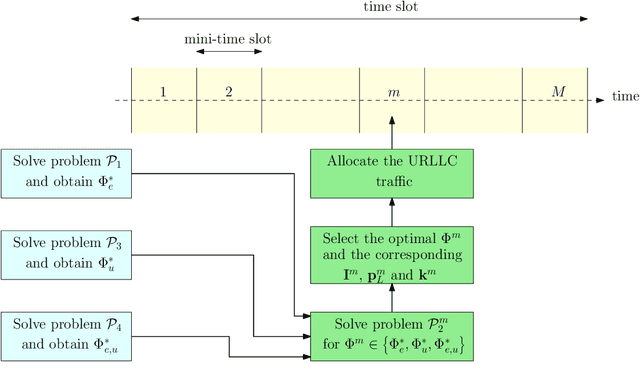


Abstract:This paper studies the coexistence of enhanced mobile broadband (eMBB) and ultra-reliable and low-latency communication (URLLC) services in a cellular network that is assisted by a reconfigurable intelligent surface (RIS). The system model consists of one base station (BS) and one RIS that is deployed to enhance the performance of both eMBB and URLLC in terms of the achievable data rate and reliability, respectively. We formulate two optimization problems, a time slot basis eMBB allocation problem and a mini-time slot basis URLLC allocation problem. The eMBB allocation problem aims at maximizing the eMBB sum rate by jointly optimizing the power allocation at the BS and the RIS phase-shift matrix while satisfying the eMBB rate constraint. On the other hand, the URLLC allocation problem is formulated as a multi-objective problem with the goal of maximizing the URLLC admitted packets and minimizing the eMBB rate loss. This is achieved by jointly optimizing the power and frequency allocations along with the RIS phase-shift matrix. In order to avoid the violation in the URLLC latency requirements, we propose a novel framework in which the RIS phase-shift matrix that enhances the URLLC reliability is proactively designed at the beginning of the time slot. For the sake of solving the URLLC allocation problem, two algorithms are proposed, namely, an optimization-based URLLC allocation algorithm and a heuristic algorithm. The simulation results show that the heuristic algorithm has a low time complexity, which makes it practical for real-time and efficient multiplexing between eMBB and URLLC traffic. In addition, using only 60 RIS elements, we observe that the proposed scheme achieves around 99.99\% URLLC packets admission rate compared to 95.6\% when there is no RIS, while also achieving up to 70\% enhancement on the eMBB sum rate.
Deep Learning Based Proactive Optimization for Indoor LiFi Systems with Channel Aging
Apr 21, 2021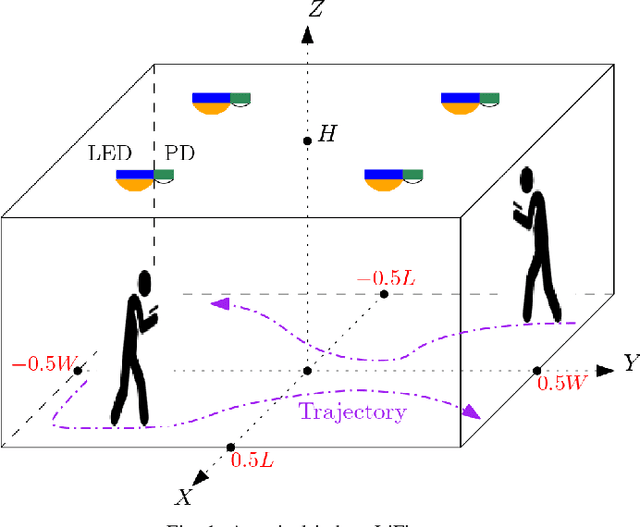
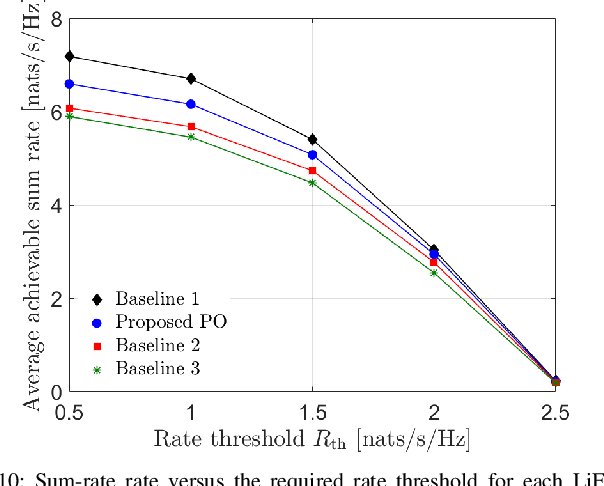

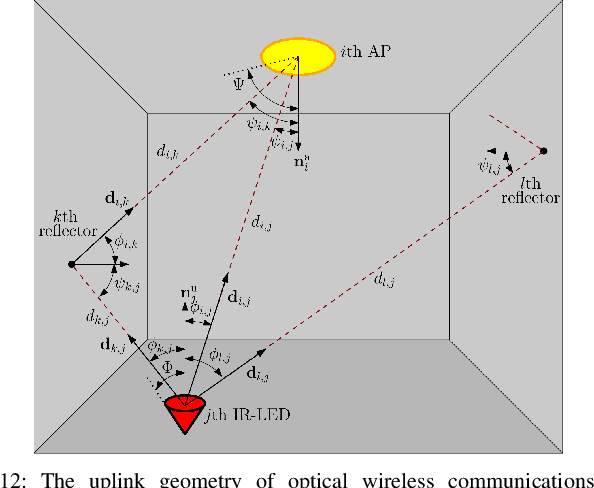
Abstract:This paper investigates the channel aging problem of light-fidelity (LiFi) systems. In the LiFi physical layer, the majority of the optimization problems for mobile users are nonconvex and require the use of dual decomposition or heuristics techniques. Such techniques are based on iterative algorithms, and often, cause a high processing time at the physical layer. Hence, the obtained solutions are no longer optimal since the LiFi channels are evolving. In this paper, a proactive-optimization approach that can alleviate the LiFi channel aging problem is proposed. The core idea is to design a long-short-term memory (LSTM) network that is capable of predicting posterior positions and orientations of mobile users, which can be then used to predict their channel coefficients. Consequently, the obtained channel coefficients can be exploited for deriving near-optimal transmission-schemes prior to the intended service-time, which enables real-time service. Through various simulations, the performance of the designed LSTM model is evaluated in terms of prediction accuracy and time. Finally, the performance of the proposed PO approach is investigated in the sum rate maximization problem of multiuser cell-free LiFi systems with quality-of-service constraints, where a performance gap of less than 7% is achieved, while eliminating up to 100% of the online processing-time.
Integration of IRS in Indoor VLC Systems: Challenges, Potential and Promising Solutions
Jan 15, 2021



Abstract:Visible light communication (VLC) is an optical wireless communication technology that is considered a promising solution for high-speed indoor connectivity. Unlike the case in conventional radio-frequency wireless systems, the VLC channel is not isotropic, meaning that the device orientation affects the channel gain significantly. In addition, due to the use of optical frequency bands, the presence of different obstacles (e.g., walls, human bodies, furniture) may easily block the VLC links. One solution to overcome these issues is the integration of the intelligent reflective surface (IRS), which is a new and revolutionizing technology that has the potential to significantly improve the performance of wireless networks. IRS is capable of smartly reconfiguring the wireless propagation environment with the use of massive low-cost passive reflecting elements integrated on a planar surface. In this paper, a framework for integrating IRS in indoor VLC systems is presented. We give an overview of IRS, including its advantages, different types and main applications in VLC systems, where we demonstrate the potential of IRS in overcoming the effects of random device orientation and links blockages. We discuss key factors pertaining to the design and integration of IRS in VLC systems, namely, the deployment of IRSs, the channel state information acquisition, the optimization of IRS configuration and the real-time IRS control. We also lay out a number of promising research directions that center around the integration of IRS in indoor VLC systems.
Reconfigurable Intelligent Surface Enabled Full-Duplex/Half-Duplex Cooperative Non-Orthogonal Multiple Access
Jan 05, 2021



Abstract:This paper investigates the downlink transmission of reconfigurable intelligent surface (RIS)-aided cooperative non-orthogonal-multiple-access (C-NOMA), where both half-duplex (HD) and full-duplex (FD) relaying modes are considered. The system model consists of one base station (BS), two users and one RIS. The goal is to minimize the total transmit power at both the BS and at the user-cooperating relay for each relaying mode by jointly optimizing the power allocation coefficients at the BS, the transmit power coefficient at the relay user, and the passive beamforming at the RIS, subject to power budget constraints, the successive interference cancellation constraint and the minimum required quality-of-service at both cellular users. To address the high-coupled optimization variables, an efficient algorithm is proposed by invoking an alternating optimization approach that decomposes the original problem into a power allocation sub-problem and a passive beamforming sub-problem, which are solved alternately. For the power allocation sub-problem, the optimal closed-form expressions for the power allocation coefficients are derived. Meanwhile, the semi-definite relaxation approach is exploited to tackle the passive beamforming sub-problem. The simulation results validate the accuracy of the derived power control closed-form expressions and demonstrate the gain in the total transmit power brought by integrating the RIS in C-NOMA networks.
A Downlink Puncturing Scheme for Simultaneous Transmission of URLLC and eMBB Traffic by Exploiting Data Similarity
Dec 27, 2020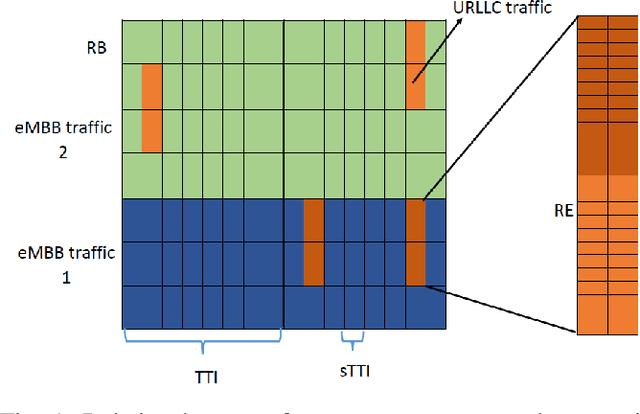
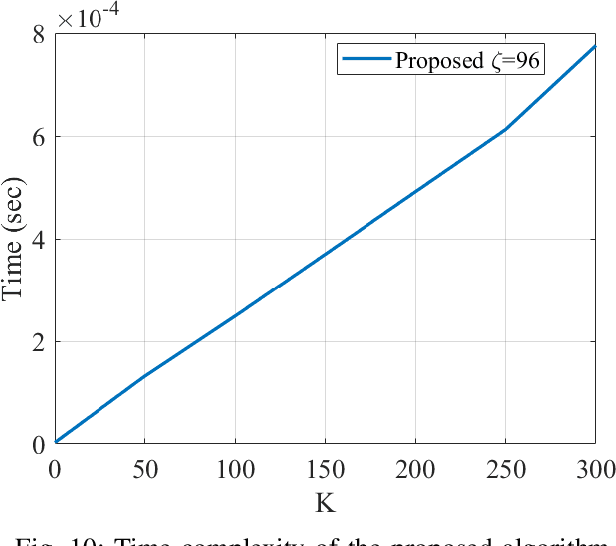
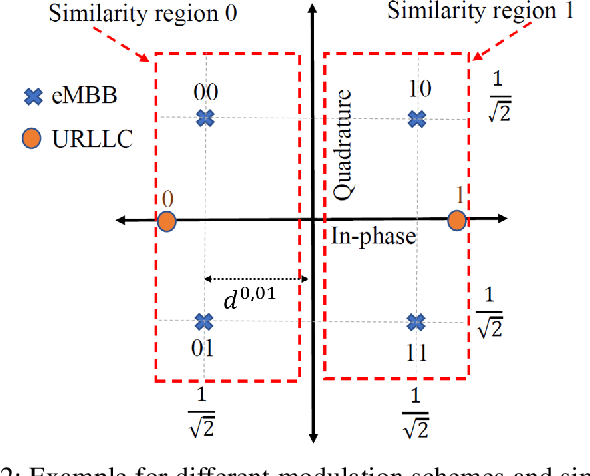
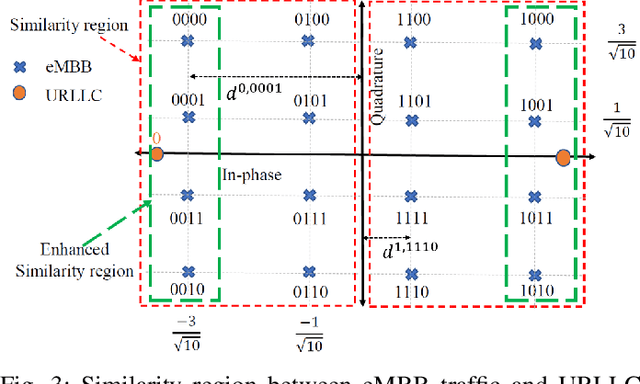
Abstract:Ultra Reliable and Low Latency Communications (URLLC) is deemed to be an essential service in 5G systems and beyond to accommodate a wide range of emerging applications with stringent latency and reliability requirements. Coexistence of URLLC alongside other service categories calls for developing spectrally efficient multiplexing techniques. Specifically, coupling URLLC and conventional enhanced Mobile BroadBand (eMBB) through superposition/puncturing naturally arises as a promising option due to the tolerance of the latter in terms of latency and reliability. The idea here is to transmit URLLC packets over resources occupied by ongoing eMBB transmissions while minimizing the impact on the eMBB transmissions. In this paper, we propose a novel downlink URLLC-eMBB multiplexing technique that exploits possible similarities among URLLC and eMBB symbols, with the objective of reducing the size of the punctured eMBB symbols. We propose that the base station scans the eMBB traffic' symbol sequences and punctures those that have the highest symbol similarity with that of the URLLC users to be served. As the eMBB and URLLC may use different constellation sizes, we introduce the concept of symbol region similarity to accommodate the different constellations. We assess the performance of the proposed scheme analytically, where we derive closed-form expressions for the symbol error rate (SER) of the eMBB and URLLC services. {We also derive an expression for the eMBB loss function due to puncturing in terms of the eMBB SER}. We demonstrate through numerical and simulation results the efficacy of the proposed scheme where we show that 1) the eMBB spectral efficiency is improved by puncturing fewer symbols, 2) the SER and reliability performance of eMBB are improved, and 3) the URLLC data is accommodated within the specified delay constraint while maintaining its reliability.
 Add to Chrome
Add to Chrome Add to Firefox
Add to Firefox Add to Edge
Add to Edge